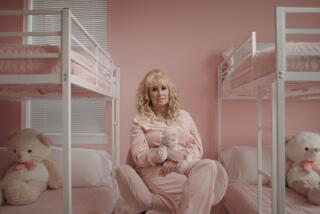‘Buddy’ Shows Its Charms by Not Aping the Pack
‘Tis the season of special effects, almost all of which will be used to raze buildings and raise blood pressure. Like the cheese they are, they stand alone, with little incorporation into plot or purpose, because they are the plot and the purpose.
And then, just when your biases against movie technology are firmly in place, along comes “Buddy,” a sweet fairy tale of a movie from the accomplished screenwriter Caroline Thompson (“Edward Scissorhands,” “The Addams Family,” “The Secret Garden”), who made such a striking directorial debut with “Black Beauty.” Through her liberated visual style and sense of wonder, Thompson is able to bestow pure magic even on a fact-based story; Gertrude Davies Lintz (Rene Russo), whose Brooklyn estate-menagerie is the setting of the film, really did raise dogs and fish and geese and apes.
But Thompson is also ably assisted by the animatronic wonders of Jim Henson Pictures, which makes Buddy (inside of whom is noted gorilla-portrayer Peter Elliott) as convincing as an animal character’s ever been--and, coincidentally, rescues technology from the Neanderthals.
“Trudy” Lintz, given a very warm and ethereal performance by Russo, collected animals. Her gorilla-sized husband, Bill (Robbie Coltrane), was a physician and Trudy was an award-winning breeder of Briard dogs. She held to the then-controversial theory (given the Scopes trial) that man and apes were one large family. Her chimps are dressed by Bergdorf-Goodman, they dine at the table and their behavior, with some exceptions, is similar to that of some normal but rambunctious human children.
But it isn’t until Buddy--a gorilla foundling--is deposited in her care that Trudy becomes missionary in her zeal, intent on proving that even this more volatile species could join her household. Things go well, and then things go badly. But Thompson makes it all ring true, with very little silly sentiment and a lot of honest emotion.
The sequence that seems askew is the same one that sets Buddy’s crisis in motion: the 1933 Chicago World’s Fair, to which Trudy is persuaded to bring her apes and put them on display. Given the dignity with which she’s treated the animals thus far, it seems uncharacteristic that she’d submit them to such an undignified exhibition. But it all proves immaterial when Buddy gets loose, wanders among the terrified crowds and has to take refuge from police and his own fear until Trudy can rescue him.
What’s really intriguing about Buddy’s transition from malleable household pet to self-asserting ape is the element of shame he feels: His memory of the fear and loathing he felt at the fair haunts him, makes him brood--to the point that when Trudy interrupts his sullen reverie, he strikes out, compounding his own trauma and the fears of the family.
We’re left with the lessons of Trudy’s hubris and, of course, the lingering image of a very sensitive, very introspective ape, who’s a lot more endearing than most of the humans populating this summer’s movies.
* MPAA rating: PG for some threatening animal action. Times guidelines: occasional fierce creatures.
(BEGIN TEXT OF INFOBOX / INFOGRAPHIC)
‘Buddy’
Rene Russo: Gertrude Davies Lintz
Robbie Coltrane: Bill
Irma P. Hall: Emma
Alan Cumming: Dick
Peter Elliott: Buddy
Paul Reubens: Professor Spatz
A Jim Henson Pictures Presents release of an American Zoetrope Production. Director Caroline Thompson. Producers Steve Nicolaides and Fred Fuchs. Executive producers Francis Ford Coppola, Stephanie Allain, Brian Henson. Screenplay by Caroline Thompson. Editor Jonathan Shaw. Music Elmer Bernstein. Production designers David Nichols and Daniel Lomino. Running time: 1 hour, 24 minutes.
* In general release.
More to Read
Only good movies
Get the Indie Focus newsletter, Mark Olsen's weekly guide to the world of cinema.
You may occasionally receive promotional content from the Los Angeles Times.










